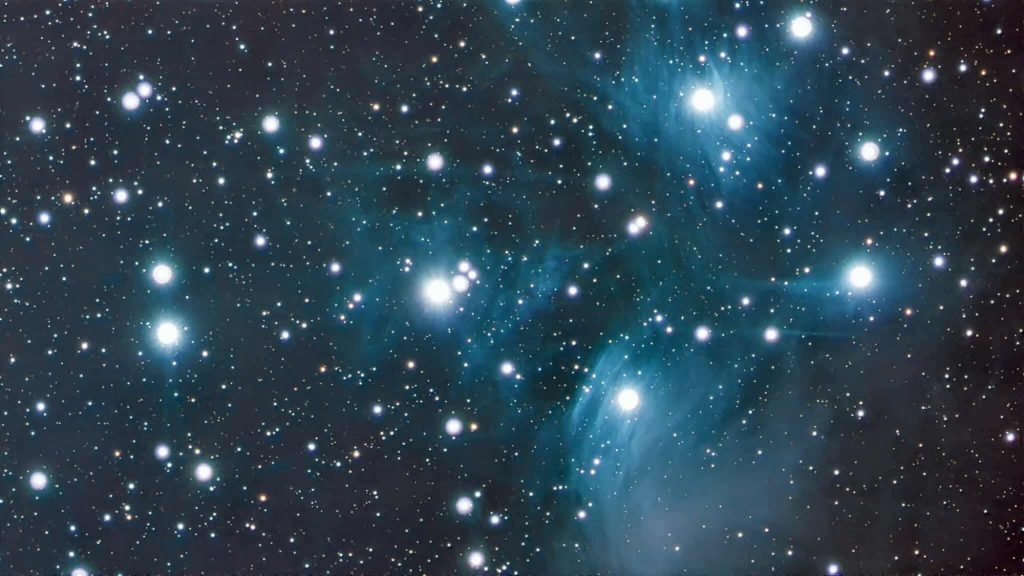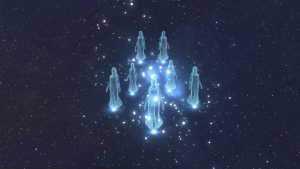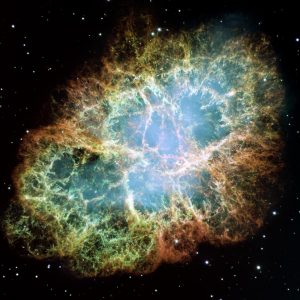Pleiades (M45): A Beginner’s Guide to the Seven Sisters — How to See Them and What You’re Looking At
What Are the Pleiades?
The Pleiades are an open star cluster about 444 light‑years away (roughly 2.6 quadrillion miles, or 2,600,000,000,000,000 miles!). Astronomers catalog it as Messier 45 (M45). It is one of the most recognizable sights in the night sky and a favorite winter target in the Northern Hemisphere.
- Over a thousand stars formed from the same giant molecular cloud
- The brightest handful make the tiny “little dipper” shape many people notice at a glance
- The cluster is young, roughly 100 million years old, making these stars true cosmic “babies”
When you look at the Pleiades tonight, the light reaching your eyes began its journey around the time Shakespeare wrote Hamlet. You are literally looking back in time.
Why Do They Look Blue?
That soft blue haze is not gas glowing from the stars themselves. It is starlight reflecting off interstellar dust, like a car’s headlights lighting up fog. Astronomers call this a reflection nebula.
How to Find the Pleiades

- Start with Orion’s Belt in the eastern sky on autumn and winter evenings
- Trace a gentle line up and to the right toward Taurus
- You will “run into” a small, glittering clump of stars — that’s M45
Best Gear

- Skip large telescopes for your first view. The cluster is so wide that high magnification crops out the beauty.
- Use binoculars, ideally 7×50 or 10×50. In dark skies the view explodes into hundreds of pinpoints.
Observing Conditions
- City skies: Expect 4–5 stars naked‑eye
- Suburban skies: 6–7 is common
- Dark skies: 8–10 or more on excellent nights
- Aim for a moonless night for the finest contrast

Will the Sisters Stay Together Forever?
Not quite. Over hundreds of millions of years, gravitational tugs will slowly pull the cluster apart. The “family” will ultimately disperse into the Milky Way.
Culture and Lore
- Known worldwide as the Seven Sisters
- In Greek myth, the daughters of the titan Atlas. Zeus placed them in the sky to escape Orion the Hunter — who still appears to “chase” them across winter evenings.
- The Subaru car brand uses a stylized Pleiades on its logo. “Subaru” is the Japanese name for the cluster.
Quick Facts (M45)
- 🌌 Distance: ~444 light‑years
- ⏳ Age: ~100 million years
- ✨ Type: Open cluster with reflection nebulae
- 📅 Best seen: Late fall through winter evenings, Northern Hemisphere
- 🔭 Best gear: Binoculars or a short‑focus wide‑field telescope
Try This Tonight
Step outside on a moonless evening. Find Orion’s Belt, slide your gaze upward, and spot the tiny dipper of blue‑white stars. In mid-November around 9 PM, look roughly 60–70° in azimuth (east-northeast) at an elevation of about 30–40° above the horizon. Count how many you can see. Then raise binoculars and let the cluster fill your view. Just look up.
Author’s Note
This article is adapted from my on‑camera script and recent imaging sessions. The Pleiades are among the most photogenic beginner targets — perfect for sharing a first “wow” moment with friends.
https://youtu.be/zoIK2PHE7jI?si=J_xR2ZtPyM0z5WGw
Share this content:



